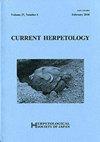日本本州中部火腹蝾螈(两栖目:尾尾目:蝾螈科)的摄食习性
IF 0.7
4区 生物学
Q4 ZOOLOGY
引用次数: 0
摘要
摘要:日本火腹蝾螈Cynops pyrrhogaster是一种濒临灭绝的物种,需要保护。在这里,我们研究了该物种在遗传上不同的种内谱系(中央谱系)中全年的进食习惯,为支持未来的原位和迁地保护活动提供信息。在日本本州岛中部京都市的稻田栖息地连续两年采集蝾螈的胃内容物。一年中,尽管陆生无脊椎动物也是蝾螈的重要猎物,但双足目水生幼虫是雄性和雌性最重要的食物来源。在猎物供应量低的时期,蜕皮也可能是一种相对有价值的食物来源。交感蛙和蝾螈似乎以不同的猎物为目标,这可能有助于它们的共存。我们的研究为pyrrhogaster中央品系在其自然栖息地和人工饲养中的合适猎物提供了新的信息。本文章由计算机程序翻译,如有差异,请以英文原文为准。
Feeding Habits of the Japanese Fire-belly Newt (Ampbihia: Urodela: Salamandridae) in Central Honshu, Japan
Abstract: The Japanese fire-belly newt, Cynops pyrrhogaster, is a near threatened species that is conservation dependent. Here, we examine feeding habits across the year within a genetically divergent intraspecific lineages of this species (the Central Lineage) to provide information to support future insitu and ex-situ conservation activities. Stomach contents from newts were collected in a paddy field habitat, Kyoto City, central Honshu, Japan for two consecutive years. Throughout the year, dipteran aquatic larvae were the most important food source both for males and females, although terrestrial invertebrates were also important prey for the newts. During periods of low prey availability shed skin could also be a relatively valuable source of food. Sympatric frogs and newts appear to target different prey and this may facilitate their co-existence. Our study provides new information on suitable prey items for the Central Lineage of C. pyrrhogaster both in its natural habitat and in captivity.
求助全文
通过发布文献求助,成功后即可免费获取论文全文。
去求助
来源期刊

Current Herpetology
Agricultural and Biological Sciences-Animal Science and Zoology
CiteScore
1.20
自引率
14.30%
发文量
20
期刊介绍:
Current Herpetology publishes original research articles on amphibians and reptiles. It is the official journal of the Herpetological Society of Japan and is a continuation of Acta Herpetologica Japonica (1964–1971) and Japanese Journal of Herpetology (1972-1999).
 求助内容:
求助内容: 应助结果提醒方式:
应助结果提醒方式:


